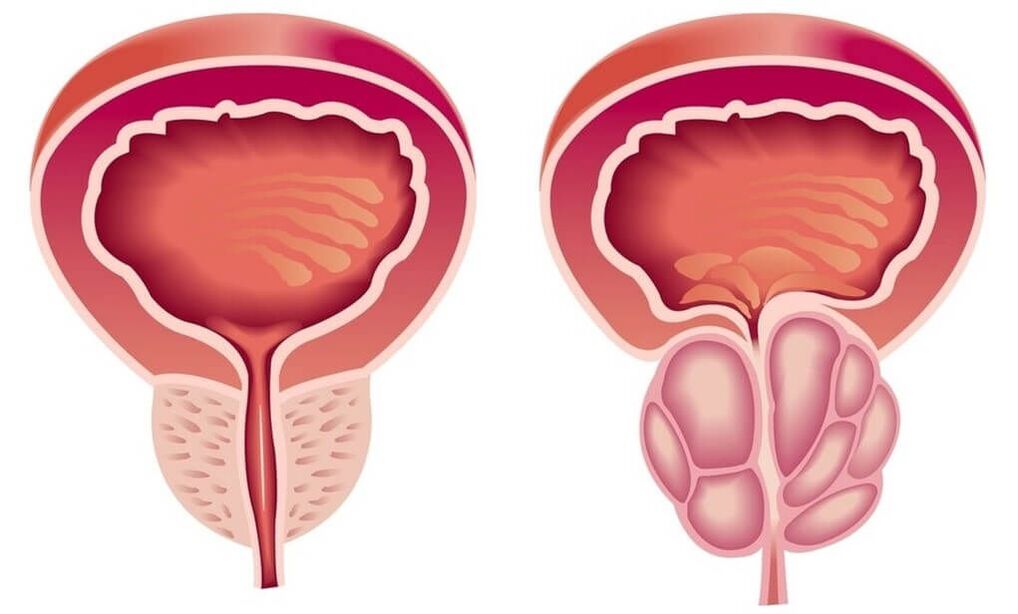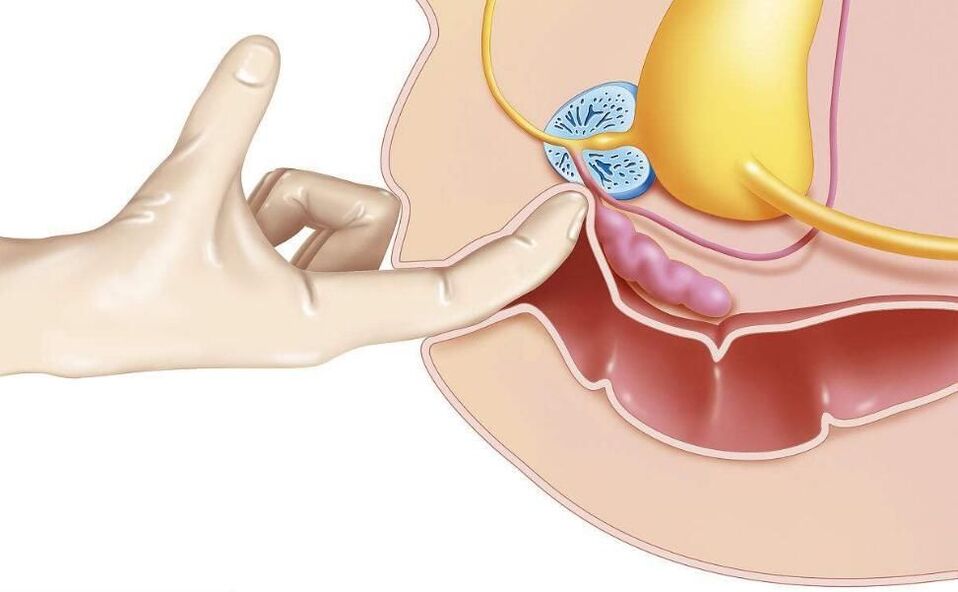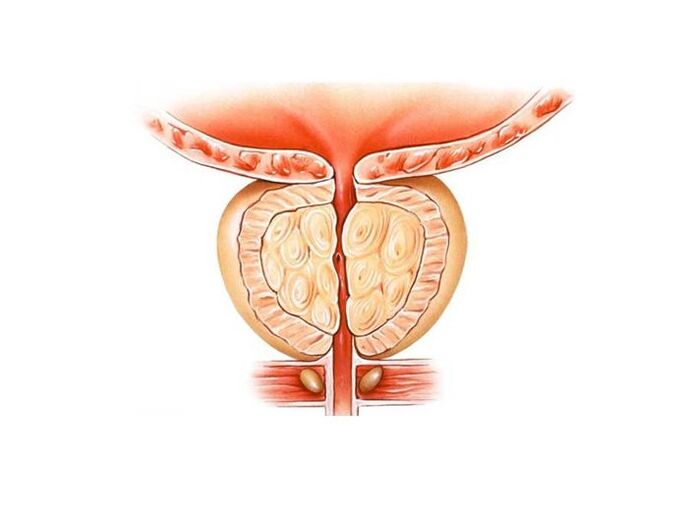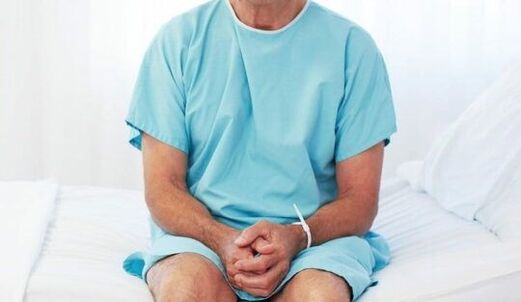prostatitisis an inflammatory disease of the prostate. Manifested by frequent urination, pain in the penis, scrotum, rectum, sexual disorders (erectile dysfunction, premature ejaculation, etc. ), sometimes urinary retention, blood in the urine. The diagnosis of prostatitis is made by a urologist or andrologist according to a typical clinical picture, the results of a rectal examination. In addition, an ultrasound of the prostate, bakposev of prostate secretion and urine is performed. Treatment is conservative - antibiotic therapy, immunotherapy, prostate massage, lifestyle correction.

general information
Prostatitis is inflammation of the seminal gland (prostate) - the prostate. It is the most common disease of the genitourinary system in men. Patients between the ages of 25 and 50 are most commonly affected. According to various reports, 30-85% of men over 30 suffer from prostatitis. Possible abscess formation of the prostate, inflammation of the testicles and appendages, which threatens infertility. The increase in infection leads to inflammation of the upper genitourinary system (cystitis, pyelonephritis).
The pathology develops with the penetration of an infectious agent that enters the prostate tissue from the organs of the genitourinary system (urethra, bladder) or from a distant focus of inflammation (in pneumonia, influenza, tonsillitis, furunculosis).

Causes of prostatitis
As infectious agents in an acute process, Staphylococcus aureus (Staphylococcus aureus), Enterococcus (Enterococcus), Enterobacter (Enterobacter), Pseudomonas (Pseudomonas), Proteus (Proteus), Klebsiella (Klebsiella) and Escherichia coli (E. Coli) can act . Most microorganisms belong to the conditionally pathogenic flora and cause prostatitis only in the presence of other predisposing factors. Chronic inflammation is usually due to polymicrobial associations.
The risk of developing the disease increases with hypothermia, a history of specific infections and conditions accompanied by congestion in the tissues of the prostate. There are the following predisposing factors:
- General hypothermia (single or permanent, associated with working conditions).
- A sedentary lifestyle, a specialty that forces a person to be in a sedentary position for a long time (computer operators, drivers, etc. ).
- Constant constipation.
- Violations of the normal rhythm of sexual activity (excessive sexual activity, prolonged abstinence, incomplete ejaculation during "habitual" intercourse without emotional coloring).
- The presence of chronic diseases (cholecystitis, bronchitis) or chronic foci of infection in the body (chronic osteomyelitis, untreated caries, tonsillitis, etc. ).
- Previous urological diseases (urethritis, cystitis, etc. ) and sexually transmitted diseases (chlamydia, trichomoniasis, gonorrhea).
- Conditions that lead to suppression of the immune system (chronic stress, irregular and improper diet, regular lack of sleep, overtraining in athletes).
It is believed that the risk of developing pathology increases with chronic intoxication (alcohol, nicotine, morphine). Some studies in the field of modern andrology prove that chronic perineal trauma (vibration, concussion) in car drivers, motorcyclists and cyclists is a provoking factor. However, the overwhelming majority of experts believe that all these circumstances are not the true causes of the disease, but only contribute to the exacerbation of the latent inflammatory process in the tissues of the prostate.
Congestion in the tissue of the prostate plays a decisive role in the development of prostatitis. Violation of capillary blood flow leads to an increase in lipid peroxidation, edema, exudation of prostate tissue and creates conditions for the development of an infectious process.
Symptoms of prostate inflammation
Acute prostatitis
There are three stages of acute prostatitis, characterized by the presence of a specific clinical picture and morphological changes:
- Acute catarrhal. Patients complain of frequent, often painful urination, pain in the sacrum and perineum.
- Acute follicles. The pain intensifies, sometimes radiating to the anus, and is aggravated by defecation. Difficult urination, urine flows in a thin stream. In some cases, urinary retention occurs. A subfebrile condition or moderate hyperthermia is typical.
- Acute parenchyma. Severe general intoxication, hyperthermia up to 38-40°C, chills. Dysuric disorders, often - acute urinary retention. Sharp, throbbing pains in perineum. Difficulty passing stool.
Chronic prostate inflammation
In rare cases, chronic prostatitis becomes the result of an acute process, but usually a primarily chronic course is observed. The temperature occasionally rises to subfebrile levels. The patient notes a slight pain in the perineum, discomfort when urinating and defecation. The most characteristic symptom is a scanty discharge from the urethra during defecation. The primary chronic form of the disease develops over a longer period of time. It is preceded by prostatosis (stasis of blood in the capillaries), which gradually turns into nonbacterial prostatitis.
Chronic prostatitis is often a complication of the inflammatory process caused by the causative agent of a particular infection (chlamydia, trichomonas, ureaplasma, gonococcus). Symptoms of a specific inflammatory process in many cases mask the manifestations of damage to the prostate. Perhaps a slight increase in pain when urinating, slight pain in the perineum, scanty discharge from the urethra with a bowel movement. A slight change in the clinical picture often goes unnoticed by the patient.
Chronic inflammation of the prostate can be manifested by a burning sensation in the urethra and perineum, dysuria, sexual dysfunction, increased general fatigue. Violations of potency (or fear of these violations) often result in mental depression, anxiety and irritability. The clinical picture does not always include all of the symptom groups listed, is different for different patients and changes over time. There are three main syndromes characteristic of chronic prostatitis: pain, dysuria, sexual dysfunction.
There are no pain receptors in the prostate tissue. The cause of pain in chronic prostatitis becomes almost inevitable due to the abundant innervation of the pelvic organs and involvement in the inflammatory process of the nerve pathways. Patients complain of pain of varying intensity - from weak, painful to intense, disturbing sleep. With ejaculation, excessive sexual activity or sexual abstinence, there is a change in the nature of the pain (intensification or weakening). The pain radiates to the scrotum, sacrum, perineum, sometimes to the lumbar region.
As a result of inflammation in chronic prostatitis, the volume of the prostate increases and compresses the urethra. The lumen of the ureter is reduced. The patient has frequent urges to urinate, a feeling of incomplete emptying of the bladder. As a rule, dysuric phenomena are expressed in the early stages. Then compensatory hypertrophy of the muscular layer of the bladder and ureters develops. The symptoms of dysuria during this period weaken, and then increase again with the decompensation of the adaptive mechanisms.
At the initial stage, dypotency can develop, which manifests itself differently in different patients. Patients may complain of frequent nocturnal erections, blurry orgasms, or worsening erections. Accelerated ejaculation is associated with a decrease in the threshold level of arousal of the orgasmic center. Painful sensations during ejaculation can cause rejection of sexual activity. In the future, sexual dysfunction will become more pronounced. In the advanced stage, impotence develops.
The degree of sexual dysfunction is determined by many factors, including the patient's sexual constitution and psychological mood. Potency disorders and dysuria can be due both to changes in the prostate and to the suggestibility of the patient, who, with chronic prostatitis, expects the inevitable development of sexual and urinary disorders. Psychogenic dypotences and dysuria develop particularly frequently in suggestible, anxious patients.
Impotence and sometimes the threat of possible sexual disorders are difficult for patients to endure. Often there is a change in character, irritability, obnoxiousness, excessive concern for one's health and even "care for the disease. "
complications
Without timely treatment of acute prostatitis, there is a significant risk of developing a prostate abscess. With the formation of a purulent focus, the patient's body temperature rises to 39-40 ° C and can become frantic. Heat waves alternate with severe chills. Stabbing pain in the perineum makes it difficult to urinate and makes it impossible to have a bowel movement.
The increase in prostate edema leads to acute urinary retention. Rarely does an abscess burst spontaneously into the urethra or rectum. When opened, purulent, cloudy urine with an unpleasant pungent odor appears in the urethra, when opened, the feces contain pus and mucus in the rectum.
Chronic prostatitis is characterized by a wavy course with periods of long-lasting remissions, during which the inflammation of the prostate is latent or manifests itself with extremely bad symptoms. Patients who are not bothered by anything often discontinue treatment and turn only when complications arise.
The spread of infection through the urinary tract causes the occurrence of pyelonephritis and cystitis. The most common complication of the chronic process is inflammation of the testicles and epididymis (epdidymo-orchitis) and inflammation of the seminal vesicles (vesiculitis). The result of these diseases is often infertility.
diagnosis
The characteristic clinical picture simplifies the diagnosis of acute and chronic prostatitis. It is mandatory:
treatment of prostatitis
Treatment of acute prostatitis
Patients with an uncomplicated acute course are treated on an outpatient basis by a urologist. In case of severe poisoning, suspected purulent process, hospitalization is indicated. Antibacterial therapy is carried out. Preparations are selected taking into account the sensitivity of the infectious agent. Antibiotics, which can easily penetrate the prostate tissue, are widespread.
With the development of acute urinary retention against the background of prostatitis, they resort to the installation of a cystostomy, and not a urethral catheter, since there is a risk of forming an abscess of the prostate. With the development of an abscess, an endoscopic transrectal or transurethral opening of the abscess is performed.
Treatment of chronic prostatitis
Treatment of chronic prostatitis should be complex, including etiotropic therapy, physiotherapy, immunity correction:
- antibiotic therapy. The patient is prescribed antibacterial drugs for a long time (within 4-8 weeks). The selection of the type and dosage of antibacterial drugs, as well as determining the duration of treatment is carried out individually. The drug is selected based on the sensitivity of the microflora according to the results of urine culture and prostate secretion.
- prostate massage.Massage of the gland has a complex effect on the affected organ. During the massage, the inflammatory secretion accumulated in the prostate is pushed out into the ducts, then enters the urethra and is removed from the body. The procedure improves blood flow to the prostate, which minimizes congestion and ensures better penetration of antibacterial drugs into the tissues of the affected organ.
- Physical therapy.Laser irradiation, ultrasonic waves and electromagnetic vibrations are used to improve blood circulation. If physiotherapeutic procedures cannot be performed, the patient is prescribed warm medicinal microclysters.
With chronic, long-term inflammation, consultation with an immunologist is indicated in order to choose the tactics of immunocorrective therapy. The patient is advised about lifestyle changes. Certain changes in the lifestyle of a patient with chronic prostatitis are both a curative and a preventive measure. The patient is recommended to normalize sleep and wakefulness, introduce a diet and engage in moderate physical activity.
Antibiotic therapy is the most effective way to treat prostatitis. Phytotherapy, immunocorrectors and hormonal preparations can also be used as prescribed by a doctor.
In the absence of acute symptoms, prostatitis can be treated with physiotherapeutic methods. Surgical intervention is recommended for abscesses and suppurations.
treatment with medication
Treatment of prostatitis with antibiotic therapy should begin with Bakposev, the purpose of which is to assess the body's sensitivity to this type of antibiotics. In violation of urination, the use of anti-inflammatory drugs is a good result.
Drugs in acute cases are taken in tablet form - in the form of a dropper or intramuscularly. For the treatment of chronic forms of prostatitis, rectal suppositories are effective: with their help, drugs reach their destination faster and have a minimal effect on other organs.
Blood-thinning and anti-inflammatory drugs have also proven effective.
Antibacterial Therapy
Antibiotics are an effective tool in the fight against bacterial prostatitis. In order to achieve the desired effect and not harm the body, the choice of drug, dosage and treatment regimen should be made by a doctor. For the correct selection of the most effective drugs, he needs to find out what kind of pathogens caused prostatitis, and also check the patient's tolerance of antibiotics of a certain group.
Antibiotics from the group of fluoroquinolones have proven themselves for the effective treatment of chronic prostatitis. Their action is aimed at suppressing bacterial infection and strengthening the body's immunity. In addition, a bacteriostatic antibiotic is recommended for the prevention and treatment of concomitant diseases of the genitourinary system.
Treatment of prostatitis caused by mycoplasma and chlamydia can be additionally carried out with macrolide and tetracycline drugs that slow the spread of infection.
The duration of taking antibacterial drugs is from 2 to 4 weeks. With positive dynamics, the course may be extended.
physical therapy
Physiotherapeutic methods in the treatment of prostatitis are aimed at activating blood circulation in the pelvic area, improving metabolic processes in the prostate, and cleaning the ducts. If physiotherapy is combined with taking antibiotics, the effect of the latter will be enhanced.
The main methods include:
- magnetotherapy;
- laser therapy;
- electrophoresis;
- warm up;
- Ultrasonic;
- sludge treatment;
- high frequency irradiation;
- Physical therapy.

One of the oldest methods, transrectal prostate massage, has no proven effectiveness according to modern research.
Non-specific treatments
Nonspecific treatments for prostatitis include:
- hirudotherapy;
- therapeutic fasting;
- Acupuncture;
- Diet according to Ostrovsky's method;
- Alkalinization of the body by Neumyvakin's method.
It is strongly recommended to coordinate any non-traditional methods of treating prostatitis with your doctor.
surgery
In complex cases and emergencies, surgical methods are resorted to:
- for drainage of purulent abscesses that are removed laparoscopically through a puncture;
- in violation of urination due to damage to the urinary tract;
- with a large volume of the affected area;
- with a significant number of stones in the body of the gland.
Stones and dead tissue are removed endoscopically. With extensive damage or multiple stones, resection of the prostate is resorted to.
Transurethral resection is also effective in bacterial prostatitis. Thus, it is possible to reduce the risk of recurrence.
home remedies

Treatment of prostatitis with folk remedies is unlikely to be effective on its own, but it can be used in combination with medical and physiotherapeutic methods. These include: beekeeping products, decoctions of herbs and seeds, tinctures of garlic, ginger, beaver brook, fresh greens, pumpkin seeds.
In acute cases of the course of the disease, it is essential to consult a doctor, in no case self-medication! With rupture of a purulent abscess, a fatal outcome is possible.
Candles for prostatitis
Treatment of prostatitis with rectal suppositories is much more effective than tablets, if only because the rectum is much closer to the prostate, which means that the drug acts faster.
The composition of drugs for the treatment of prostatitis can be completely different, they are prescribed to solve a specific problem.
- Antibacterial agents are especially effective in prostatitis caused by chlamydia.
- Painkillers are used for symptomatic treatment, they relieve pain well.
- Immunostimulants improve blood circulation, relieve swelling and are used in complex therapy.
- Phytopreparations have a mild effect. They, like candles, are used on bee products as an adjunct to the main treatment.
- Compositions based on ichthyol promote blood circulation in the area of \u200b\u200bthe intestinal mucosa, which accelerates the weakening of inflammatory processes and slightly improves immunity.
- Enzyme-based products prevent scar tissue from forming. It is recommended to take as part of complex therapy with antibiotics, anti-inflammatory and analgesic drugs.
auxiliary drugs
For the symptomatic treatment of prostatitis in men, such as relieving pain when urinating, you can additionally take antispasmodic drugs that relax smooth muscles, thereby quickly relieving pain.
Blood-thinning and anti-inflammatory supplements based on bee products, pumpkin seed oil, palm fruit extracts contribute to general recovery.
diet and lifestyle
Proper, balanced diet and a healthy lifestyle are very important for the treatment of prostatitis. The food should not contain spicy, fried, salty, pickled foods. In the acute form, alcohol is strictly prohibited.
Food should contain enough fiber to prevent constipation. The protein content should be reduced. It is desirable to supplement the diet with herbs, ginger and pumpkin seeds.
Non-drug treatment
Non-drug methods of therapy allow you to act directly on the prostate, increasing the concentration of drugs in its tissues and removing congestion.
Microwave hyperthermia is performed using a rectal probe inserted into the patient's anus. You can set the temperature required for a specific type of exposure on the device. To increase the concentration of the drug in the prostate, warming to 38-40°C is required. To achieve antibacterial effect - 40-45 ° C.
Today, non-drug treatment focuses on laser therapy. The possibilities of this technology are wide-ranging. Under the influence of a laser, the following processes occur in the prostate:
- activation of redox reactions;
- improves blood microcirculation;
- new capillaries are formed;
- pathogenic microflora is suppressed;
- The process of cell division is activated, which contributes to tissue regeneration.
During the study of the effects of laser therapy on patients with prostatitis, one side effect was noted, but it was positive for the purposes of treatment. In those who completed the course, potency increased, erectile dysfunction was eliminated, and vitality was restored. To achieve this result it is necessary to use a beam with a specific wavelength. Generally, low-intensity laser radiation is used to treat chronic prostatitis.
Patients can undergo laser therapy on their own initiative, if not prescribed by the attending physician.
Surgical treatment of chronic prostatitis
Chronic prostatitis does not pose a threat to the patient's life, but it can significantly affect its quality. The most serious complication of this disease is the formation of stones in the tissues of the gland. To rid it of prostoliths, transurethral resection is performed.
The operation will be carried out under the control of TRUS.
If complications such as prostate sclerosis occur, transurethral electrosurgery is performed. If sclerosis of the neck of the bladder is observed in combination with this pathology, a partial resection of the prostate is performed.
With blockage of the seminal and excretory ducts, endoscopic operations are indicated to eliminate violations of the patency of the secret. To do this, an incision is made in the seminal vesicles and ducts. If an abscess occurs, complete removal of the gland is possible.
Consequences of untreated prostatitis

Even if the symptoms of prostatitis do not appear for a long time, regular examination by a urologist is necessary. Prostatitis that has not completely healed can be accompanied by the formation of calcifications, which then have to be removed together with the gland. Experts are sure that there are no other ways to remove or dissolve stones.
In addition, pathogenic microorganisms can migrate to neighboring organs and cause inflammation. Ongoing prostatitis can cause the development of adenomas and prostate cancer.
prognosis and prevention
Acute prostatitis is a disease that has a pronounced tendency to become chronic. Even with timely adequate treatment, more than half of patients end up with chronic prostatitis. Recovery is far from always achieved, but with the right consistent therapy and according to the doctor's recommendation, it is possible to eliminate unpleasant symptoms and, in the case of a chronic course, to achieve long-term stable remission.
Prevention means eliminating risk factors. It is necessary to avoid hypothermia, alternate between sedentary work and periods of physical activity, eat regularly and fully. In case of constipation, laxatives should be used. One of the preventive measures is the normalization of sex life, since both excessive sexual activity and sexual abstinence are risk factors for the development of prostatitis. If symptoms of a urological or sexually transmitted disease appear, you should consult a doctor in good time.































